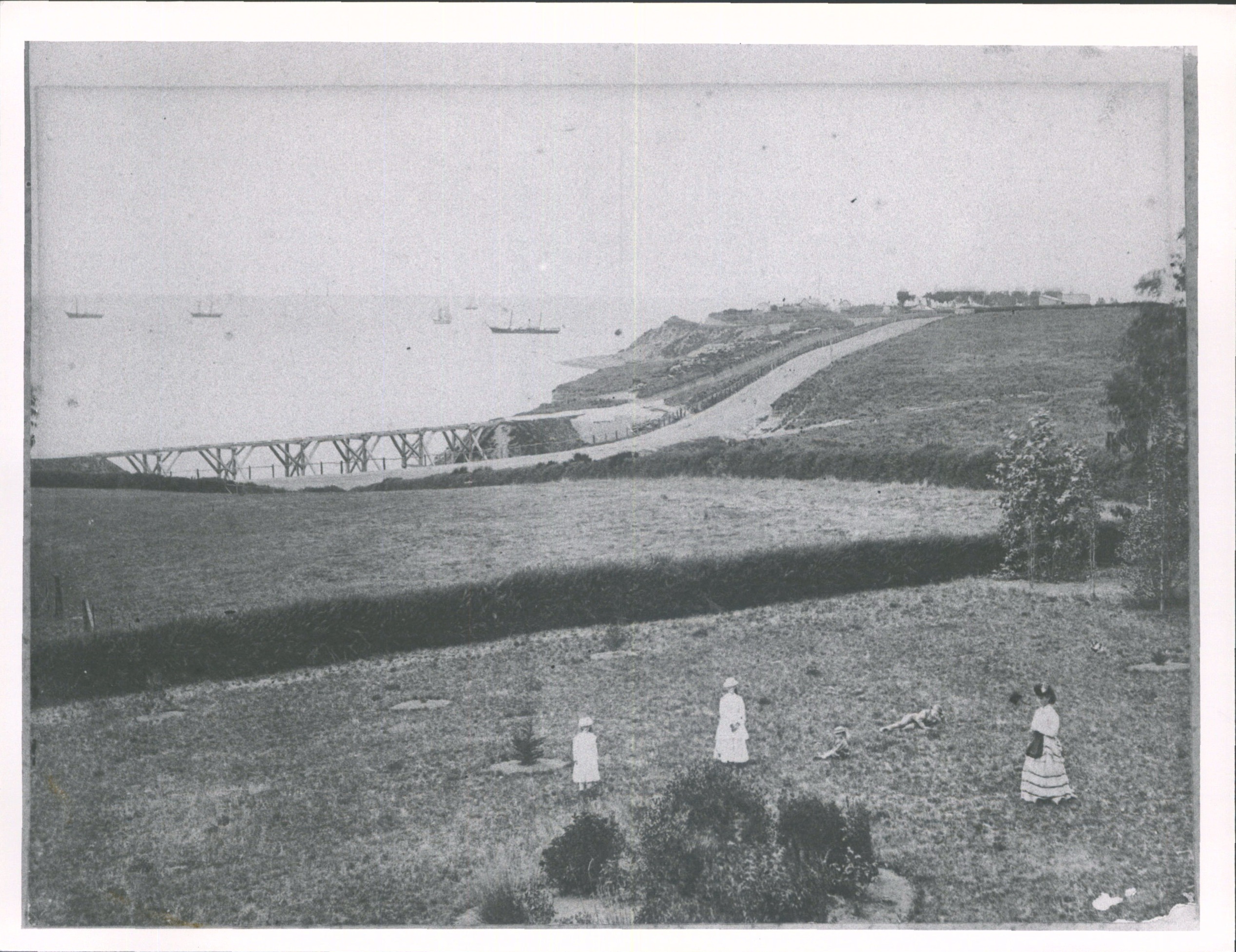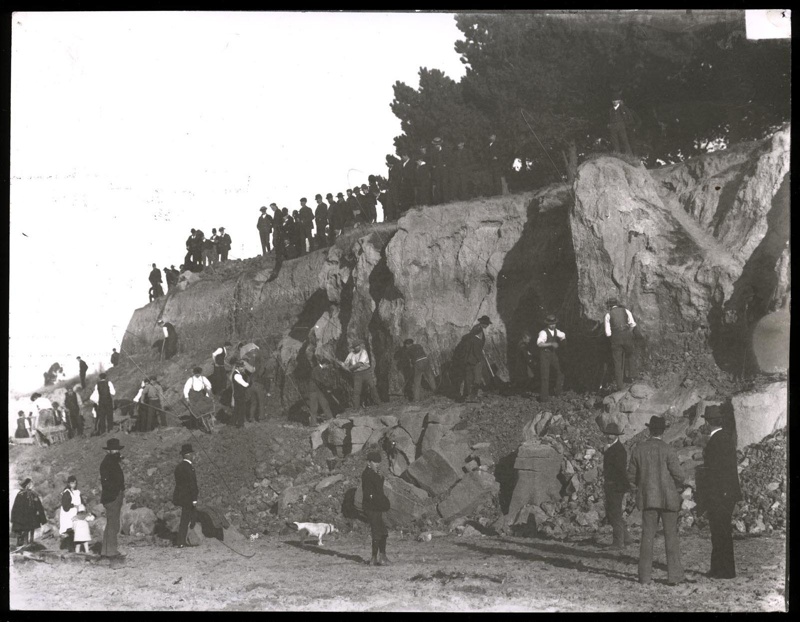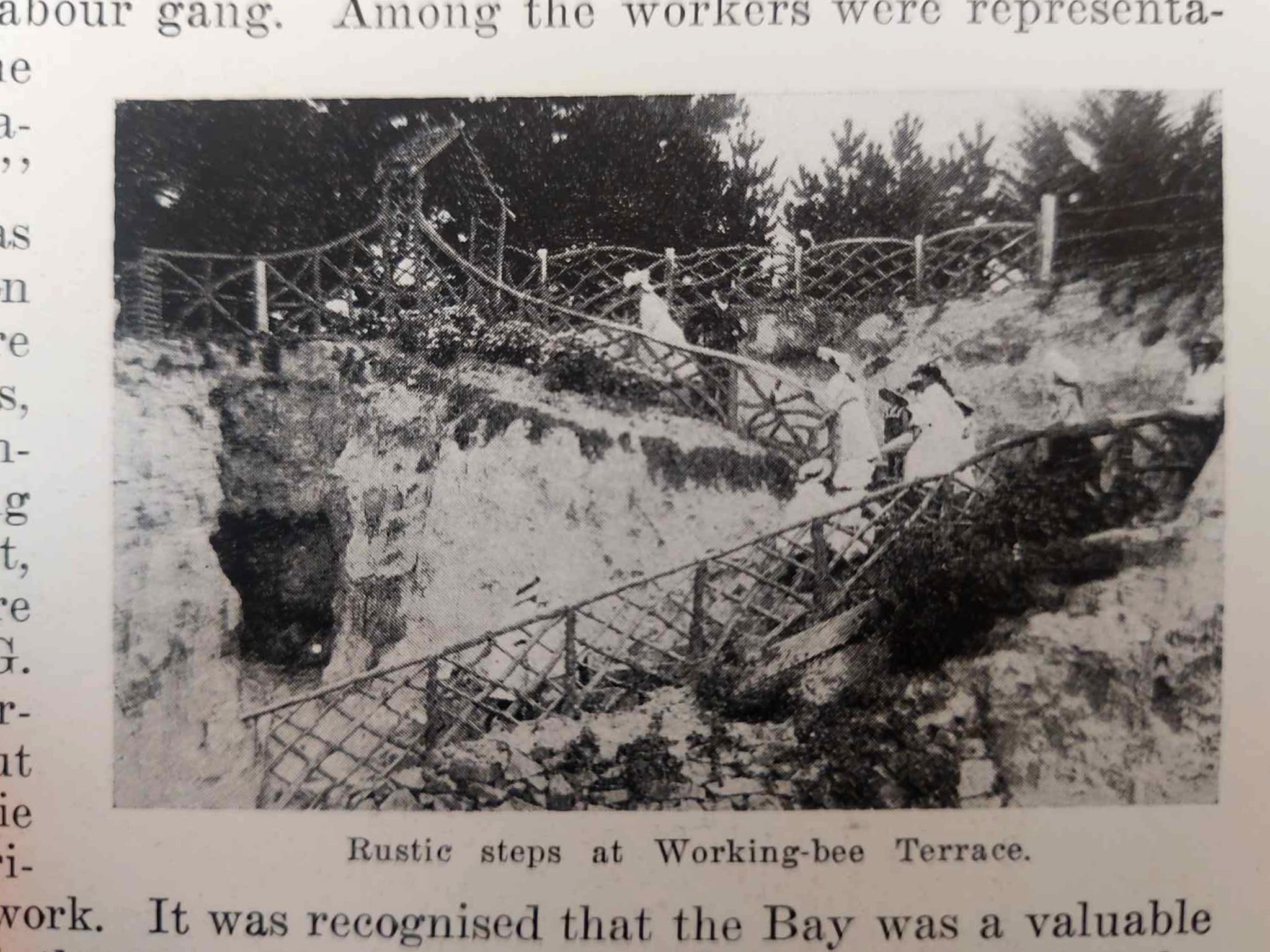Caroline Bay Improvements
As the town stands back from the sea, it has given to the business men of the town valuable land for mercantile building sites, on the reclaimed shingle area, so it has given to the children of the town a valuable recreation ground, in the sands of Caroline Bay. The formation of the sandy beach of this Bay has been dealt with in the chapter on the Port, and it only remains here to say with what grace the inhabitants have accepted the boon the sea has conferred.

Caroline Bay, North end. W. Ferrier, photo. Hocken Digital Collections, accessed 17/04/2025, https://hocken.recollect.co.nz/nodes/view/26238 Low quality image. For further information on use of low quality scans and on how to order a high quality image please see conditions of use.
Needless to say, the children of the town were as ready to take advantage of the sands as their fathers were to take advantage of the shingle, and Caroline Bay soon became a favourite resort.
The absolute pioneer in the matter of beautifying at the Bay was W. Rutherford. He planted the firs, still growing at the cliff edge, to hide a rubbish and nightsoil shoot in use there at that time.
 View from Beverley, Timaru.
View from Beverley, Timaru.
First Whales Creek viaduct. Main North Road. Caroline Bay. LeCren’s Terrace. Melville Hill. Lough's House (site of Hydro Hotel) Sarah Street, Hewlings St, Wai-iti Rd.
Looking towards the sea near Timaru (1871-1875). Hocken Digital Collections, accessed 17/04/2025, https://hocken.recollect.co.nz/nodes/view/23692 Low quality image. For further information on use of low-quality scans and on how to order a high-quality image please see the conditions of use.
At a public meeting held on 18th May, 1897, for considering the celebration of the record reign of Queen Victoria, general discussion took place for the first time of the advisableness of cutting down the cliffs, levelling up the spoil, and generally improving the appearance of the Bay. The cost of a sea-wall to protect the clay when thrown down and spread was, however, thought to be too great to admit of the scheme being adopted as part of the proposed celebrations, and it was decided that it must be abandoned.

The 'Working Bee' at Caroline Bay. 1897 - William Ferrier.
First improvements. Caroline Bay, 1897. Men working on the removal of the cliff on the western side of Caroline Bay in 1897. Depicts a large group of men working on a cutting along the cliff face, while others watch on from the the top and foot of the cliff. South Canterbury Museum CN 0488
On 4th June, however, David Stuart waited on the Harbour Board to explain a letter sent in with a plan of proposed work, and the Board decided to grant the request for discarded ironbark and other timbers, for the purpose of erecting a protective sea wall. By 17th June the timbers had been carted to the bay by volunteers, work was begun, and carried on by 4 or 5 wages men under the honorary direction of G. Stumbles. Every Thursday afternoon for two months afterwards, volunteers undertook pick and shovel work, whilst ladies of the town provided them with afternoon tea. “On Thursday afternoon, July 15th,” said the “Herald,” “there were 50 volunteers at work, and blistered palms were plentiful in the soft-labour gang. Among the workers were representatives of the military, the Church, medicine, law, literature, commerce and trade..."
As it was found the sand was making, and no protection was needed, the timbers were removed and utilized as seats, steps, etc. The work was continued by the Beautifying Association, and the project, originated in large measure with D. Stuart and G. Stumbles, was not only carried out as time went on, but extended; and on J. Craigie becoming Mayor in 1902, private work became a public work. It was recognised that the Bay was a valuable adjunct to the Town, and that any expenditure would be justified by the additional attraction it would make to the Borough. The Harbour Board granted to the Borough Council a lease of 94 acres, free of rent, including the whole of the Bay on which improvements were to be made, and a prize of £10 10s. was offered in October, 1902, by J. Craigie for the best beautifying scheme. The scheme of J. Morris was adjudged the most suitable, and with the exception of a few minor details, it was carried into effect.

Gibson Steps were built by Mr Gibson the caretaker of Caroline Bay from 1904 - 1939. The stairs have rustic wooden (Kauri) railings along the side and an archway at the top made of the same wood. The fence along the cliff on either side of the steps is also of the same rustic wood.
 Caroline Bay: The first lawn. - Photo taken from the book South Canterbury Jubalee History 1916
Caroline Bay: The first lawn. - Photo taken from the book South Canterbury Jubalee History 1916

Caroline Bay: Children's Gala Day - South Canterbury Jubalee History 1916 - photo from book

Caroline Bay in Summer. W. Ferrier, photo - South Canterbury Jubalee History 1916 - photo from book
It was necessary sary for the Council to borrow £2,500 for the work, and private subscriptions in addition enabled a sum of about £3,400 to be spent within the following 3 or 4 years. Still further improvements were projected, and the north mole was transformed into a marine parade. In order to enable the Borough Council to spend funds upon this work, a lease rent free was granted by the Harbour Board; and the Board furthermore gave £150 towards the improvement of the mole and the bay. In August, 1911, the Caroline Bay Association was formed, a body whose sole function was the planning and executing further improvements. The beauty of the Bay appeals at once to the visitor: the firm stretch of sand lipped by quiet waters, the brilliant gardens amid sober green, the terraces and sloping pathways, grown with veronicas, cabbage trees and other graceful shrubs, the rustic railings, the cottages, the band rotunda, the kiosk, and above the cliff the town, all make an exquisite picture, the human interest intensified by the bustling life on the beach and on the cliffs. Seats presented by various citizens are plentiful, as are swings and other seaside amusements for children, and bathing conveniences for all. The first public baths in the bay were established by E. Yardley, and opened on 30th January, 1877, but the first public convenience for bathers generally was a tent erected privately in October, 1869, under the cliffs a short distance north of the Government flagstaff. From the Parade the view of the Bay improvments is subdued and blends well with the general picturesqueness, backed by the range of mountain, especially magnificent in winter, running from the Four Peaks block through Fox Peak, a fine sharp mountain, to Mount Burgess, the southern buttress of the Two Thumb Range, thence through the dip of Burke’s Pass into the Hunters Hills. The Bay forms a pleasant resort in summer or winter; for whilst it lies open to the cool sea breezes, it is perfectly sheltered by the cliffs from the bleak winter winds off the snowy mountains.

View from the Marine Parade. W. Ferrier, photo.

